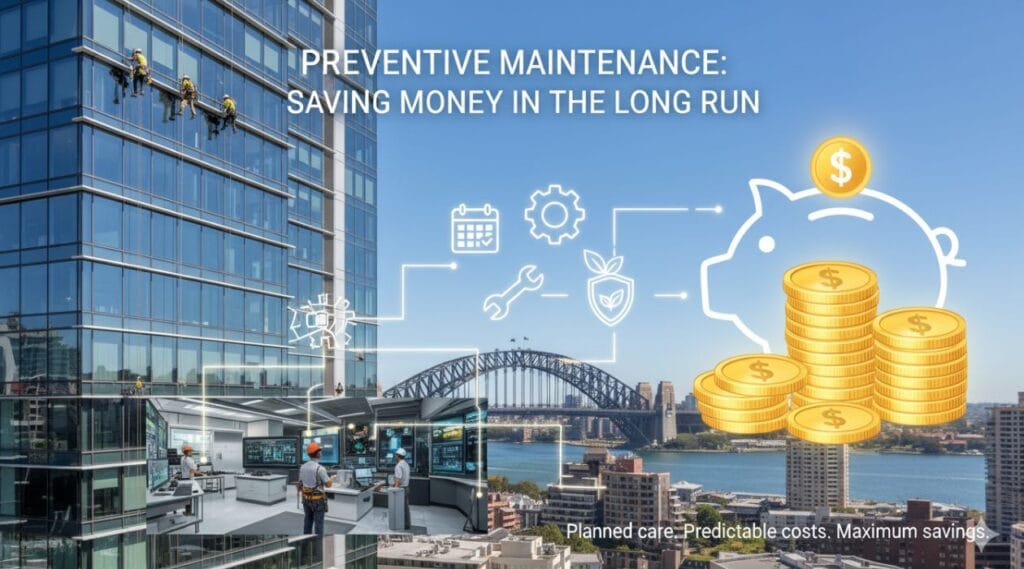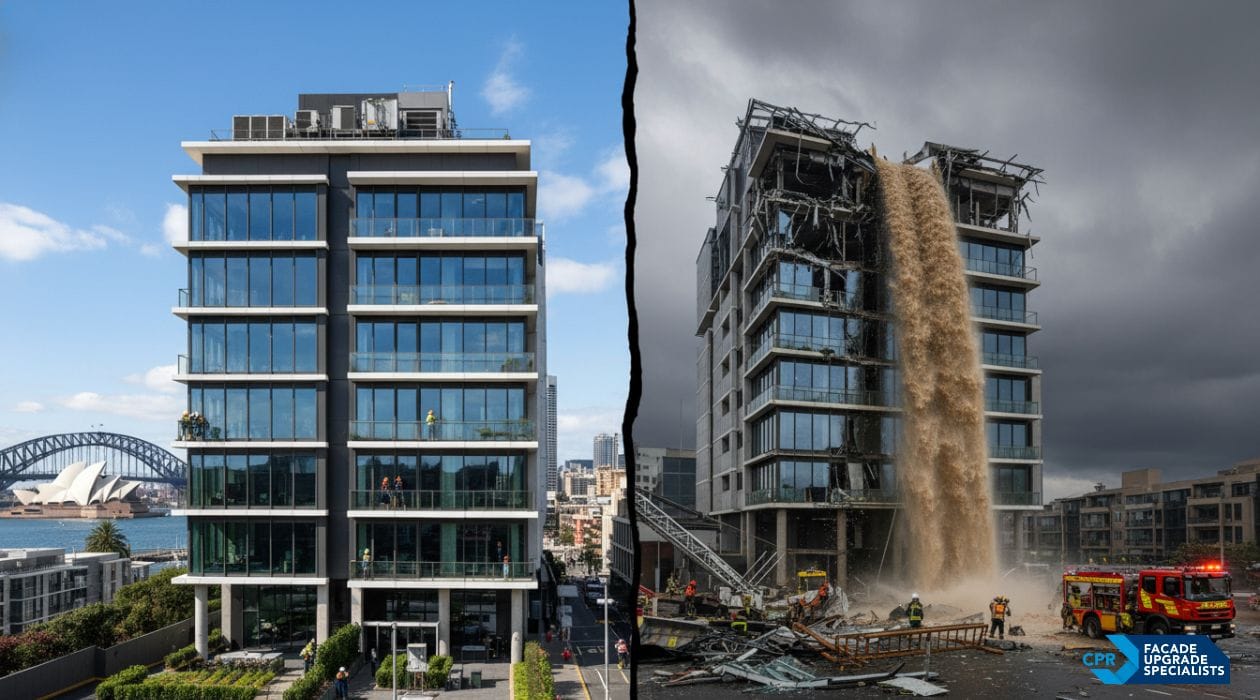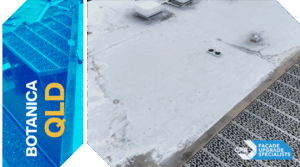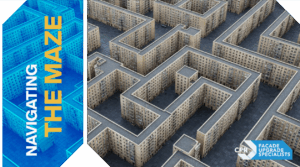Building maintenance is one of the most critical investments for any strata committee, property manager, or consultant. Yet, many buildings across Australia continue to rely on reactive maintenance—fixing problems only after they appear—rather than investing in preventive strategies. The question remains: when comparing preventive vs reactive maintenance, which approach truly saves more in cost, time, and long-term building health?
At CPR Facade Upgrade Specialists, we’ve seen first-hand the financial and structural consequences of neglecting early maintenance. Through our Scaffold-Free™ systems (MARS™, PEARS®, SkyPod®) and SKY-FIMMS™ data-driven inspections, we help clients make smarter, proactive decisions that prevent costly emergencies and extend asset life. Learn more about our approach through our Facade Remedial Consultancy and discover how early intervention can save thousands in long-term costs.
What Are Preventive and Reactive Building Maintenance Strategies?
What Is Preventive Building Maintenance?
Preventive maintenance—often called proactive maintenance—is the systematic approach of performing regular inspections, minor repairs, and component replacements to prevent failures before they occur. Examples include routine facade inspections, sealing joints before leaks form, and cleaning drainage systems to prevent water ingress.
Preventive maintenance reduces risk, ensures compliance, and significantly extends your building asset lifespan. For strata committees, this means fewer special levies, fewer emergencies, and more predictable budgets. If your building hasn’t undergone a detailed inspection recently, consider booking a SKY-FIMMS™ digital twin assessment to pinpoint potential issues before they escalate.
What Is Reactive Building Maintenance?
Reactive maintenance, on the other hand, involves responding to failures as they happen. Examples include emergency leak repairs, concrete spalling treatment after damage, or urgent facade restoration following water ingress.
While reactive maintenance might seem cost-saving initially—since work is only done when needed—it often leads to higher expenses, greater disruption, and accelerated deterioration. In most cases, “fixing later” means “paying more.” For building managers aiming to reduce these emergencies, CPR’s Facade Remediation & Preservation program offers structured, low-disruption solutions tailored for high-rise and difficult-access sites.
Preventive vs Reactive Maintenance: Understanding the Key Differences
1. Timing and Planning
Preventive: Scheduled maintenance and inspections are performed regularly to catch early warning signs. With CPR’s SKY-FIMMS™ digital twin, every facade element is mapped and monitored, ensuring no defect goes unnoticed.
Reactive: Work begins only after a visible problem arises, often under urgent conditions. This leads to rushed decision-making and unplanned expenses.
2. Maintenance Costs and Budget Impact
Preventive: Involves planned, smaller expenditures spread over time. This stabilises the maintenance budget and prevents sudden cost blowouts.
Reactive: Leads to unpredictable and often much higher expenses. Emergency works require premium rates and often include collateral damage repairs.
3. Downtime and Disruption
Preventive: Routine work is discreet and scheduled to minimise disturbance. With our Scaffold-Free™ systems, we perform facade inspections and repairs externally—no scaffolds, no intrusions.
Reactive: Emergency works can cause major interruptions to residents, businesses, or government operations, especially when scaffolding or urgent mobilisation is required.
4. Asset Lifespan and Longevity
Preventive: Regular care extends the life of key materials such as concrete, coatings, and sealants—delaying the need for major refurbishments by years.
Reactive: Delayed intervention accelerates deterioration, causing hidden damage that shortens asset lifespan and increases overall costs.
5. Safety and Risk Management
Preventive: Identifies and mitigates hazards before they become safety threats. This protects residents, workers, and the property’s reputation.
Reactive: Exposes occupants and stakeholders to risks—such as falling debris or water ingress—that could lead to insurance claims or compliance issues.
6. Organisational Efficiency and Scheduling
Preventive: Predictable scheduling allows strata committees and managers to plan financially and operationally.
Reactive: Sudden emergencies disrupt other building operations, forcing committees and managers into crisis mode.
7. Sustainability and Environmental Impact
Preventive: Reduces waste, extends material life, and promotes sustainability by avoiding unnecessary replacements.
Reactive: Often requires replacement of damaged materials, generating more waste and emissions.
Cost Comparison: Which Building Maintenance Strategy Saves More Money?

Preventive maintenance provides measurable long-term savings. Industry research indicates that every dollar invested in preventive maintenance can save up to four dollars in future repair costs.
At CPR, our clients regularly experience cost savings of up to 20% across entire facade remediation projects by adopting our data-driven approach through SKY-FIMMS™. This platform provides accurate defect mapping, enabling precise budgets and eliminating surprise costs. Many clients first discover these savings through a consultation session with our remediation specialists, where we identify the highest-value preventive measures for their buildings.
For example, a 10-storey building in Sydney’s Inner West avoided a $1.2 million scaffold expense by choosing our Scaffold-Free™ SkyPod® workstations for planned facade preservation—completed quietly, safely, and ahead of schedule.
Combining Preventive and Reactive Maintenance for Optimal Results
While preventive maintenance should always be the foundation, reactive maintenance still has its place for unforeseen issues. A hybrid strategy—supported by predictive tools like SKY-FIMMS™—allows property managers to combine real-time monitoring with planned interventions.
Predictive maintenance, driven by data from regular inspections, ensures your maintenance is targeted and cost-efficient. With CPR’s systems, strata committees can see, track, and manage every defect digitally, turning maintenance into an informed, transparent process. Explore how this hybrid approach works in practice through our Facade Remediation & Preservation service page.
CPR Facade Upgrade Specialists: Your Partner in Smart Building Maintenance
At CPR, we redefine how Australia maintains its buildings. Through our Scaffold-Free™ access systems—MARS™, PEARS®, and SkyPod®—and SKY-FIMMS™ 3D digital twin technology, we deliver safe, cost-effective, and transparent maintenance solutions that protect assets for decades.
Our quality assurance systems—ASP’s™ (Accredited Service Partners™), SFS360® (Sky Facade Scope 360™), and SE2EPC® (Sky End 2 End Project Care®)—ensure every detail is inspected, verified, and documented. From initial inspection to long-term preservation under AssetCare™, we provide total peace of mind—ensuring your building remains safe, compliant, and beautiful for generations.
Ready to move from reactive headaches to preventive confidence? Book your consultation today and see how CPR’s approach can transform the way you maintain your building.






